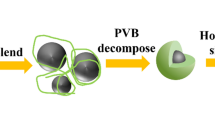Abstract
Zirconium diboride (ZrB2) based ultra-high temperature ceramics either unmodified or with SiC particulate additions of 10, 20, or 30 volume percent were prepared by conventional hot pressing. The ZrB2-SiC compositions had improved four-point bend strength compared to the ZrB2 prepared in our laboratory as well as other reported ZrB2 or ZrB2-SiC materials. Strength and toughness increased as the amount of SiC increased. Measured strengths ranged from ∼550 MPa for ZrB2 to over 1000 MPa for ZrB2-30% SiC. Likewise, toughness increased from 3.5 MPa to more than 5 MPa over the same composition range. The addition of SiC also improved oxidation resistance compared to pure ZrB2.
Co-extrusion processing was used to produce ZrB2-based ultra-high temperature ceramics with a fibrous monolithic structure. Samples had dense ZrB2-30 vol% SiC cells approximately 100 μm in diameter surrounded by porous ZrB2 cell boundaries approximately 20 μm thick. ZrB2-based fibrous monoliths had four point bend strength of ∼450 MPa, about half of a conventional ZrB2-SiC ceramic with the cell composition. Preliminary analysis of fracture behavior found that ZrB2-based fibrous monoliths did not exhibit graceful failure because the difference in strength between the cell and cell boundary of the current materials was not sufficient.
Similar content being viewed by others
References
R. TELLE, L. S. SIGL and K. TAKAGI, in “Handbook of Ceramic Hard Materials” edited by R. Riedel (Wiley-VCH, Weinheim, 2000) p. 803.
R. A. CUTLER, in “Ceramics and Glasses, Engineered Materials Handbook”, edited by S. J. Schneider, Jr. (ASM International, Materials Park, OH, 1991) p. 787.
N. KAJI, H. SHIKANO and I. TANAKA, Taikabutsu Overseas 44 (1992) 387.
G.-J. ZHANG, Z.-Y. DENG, N. KONDO, J.-F. YANG and T. OHJI, J. Amer. Ceram. Soc. 83 (2000) 2330.
F. MONTEVERDE, A. BELLOSI and S. BUICCIARDI, J. Euro. Ceram. Soc. 22 (2002) 279.
C. MROZ, “Zirconium Diboride”, Amer. Ceram. Soc. Bull. 73 (1994) 141.
A. GOLDSTEIN, Y. GEFFEN and A. GOLDENBERG, J. Amer. Ceram. Soc. 84 (2001) 642.
H. ZHAO, Y. HE and Z. JIN, ibid. 78 (1995) 2534.
S. K. MISHRA, S. K. DAS, A. K. RAY and P. RAMACHANDRARAO,ibid. 85 (2002) 2846.
A. L. CHAMBERLAIN, W. G. FAHRENHOLTZ, G. E. HILMAS and D. T. ELLERBY, “High Strength ZrB2-Based Ceramics, ” J. Amer. Ceram. Soc. 87(6) (2004) 1170.
Figure 9020 in “Phase Equilibria Diagrams—Phase Diagrams for Ceramists Vol. X: Borides, Carbides, and Nitrides”, edited by A. E. McHale (The American Ceramic Society, 1994).
E. CLOUGHERTY, R. HILL, W. RHODES and E. PETERS, “Research and Development of Refractory Oxidation-Resistant Diborides, Part II, Vol. II: Processing and Characterization”, Technical Report No. AFML-TR-68-190 (1970).
D. POPOVICH, J. W. HALLORAN, G. E. HILMAS, G. A. BRADY, G. ZYWICKI, S. SOMERS and A. BARDA, “Process for Preparing Textured Ceramic Composites”, U.S. Patent No. 5,645,781, issue date July 8, 1997.
G. E. HILMAS, G. A. BRADY and J. W. HALLORAN, in Ceramic Transactions, Vol. 51, Fifth Int'l Conf. on Ceramic Processing Science and Technology, edited by H. Hausner, G. L Messing and S.-I. Hirano (American Ceramic Society, Westerville, OH, 1995) p. 609.
J. S. REED, in “Principles of Ceramics Processing” (John Wiley and Sons, New York, 1995) p. 280.
“High Temperature Oxidation Exposure Testing of Non-Oxide Advanced Ceramics at Atmospheric Pressure and Low Gas Velocities”, under consideration by ASTM C-28.
Figure 8851 in “Phase Equilibria Diagrams—Phase Diagrams for Ceramists Vol. X: Borides, Carbides, and Nitrides”, edited by A. E. McHALE (The American Ceramic Society, 1994).
E. RUDY, “Part V. Compendium of Phase Diagram Data”, Ternary Phase Equilibria in Transition Metal-Boron-Carbon-Silicon Systems, Technical Report AFML-TR-65-2, Air Force Materials Laboratory, Wright-Patterson Air Force Base, OH (1969).
T. OHJI, Y. K. JEONG, Y. H. CHOA and K. NIIHARA, J. Amer. Ceram. Soc. 81 (1998) 1453.
K. S. BLANKS, A. KRISTOFFERSSON, E. CARLSTÖM and W. J. CLEGG, J. Euro. Ceram. Soc. 18 (1998) 1945.
Author information
Authors and Affiliations
Rights and permissions
About this article
Cite this article
Fahrenholtz, W.G., Hilmas, G.E., Chamberlain, A.L. et al. Processing and characterization of ZrB2-based ultra-high temperature monolithic and fibrous monolithic ceramics. Journal of Materials Science 39, 5951–5957 (2004). https://doi.org/10.1023/B:JMSC.0000041691.41116.bf
Issue Date:
DOI: https://doi.org/10.1023/B:JMSC.0000041691.41116.bf




